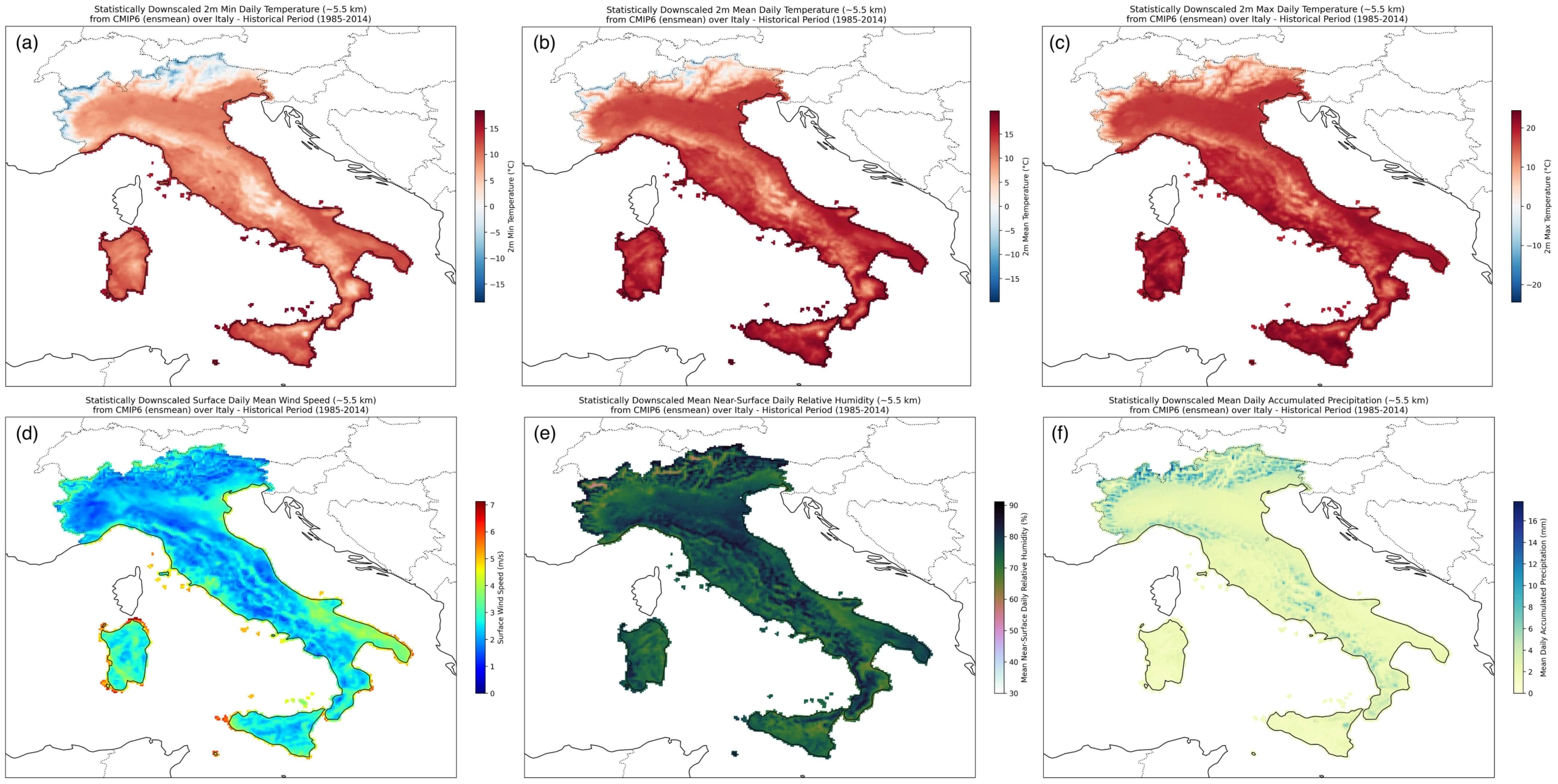
From coastal wind patterns to regional temperatures and precipitation, CMCC delivers the first high‐resolution CMIP6‐based climate dataset tailored for Italy, so that researchers and planners can gain access to high-resolution and reliable information on potential future climate conditions and reproduce Italy’s local climate, up to the year 2100, with higher detail. “We now offer not just a more detailed view of expected climate conditions but also a transparent understanding of the uncertainties involved considering the new IPCC scenarios. This depth of detail is crucial for designing resilient infrastructure and protecting both communities and ecosystems from the impacts of climate change,” says Giusy Fedele, CMCC researcher and lead author of the latest peer-reviewed paper that describes the methodology and the structure of the dataset in detail.
A new study, conducted entirely by CMCC researchers, presents a high-resolution dataset (SD-EQM_GCMs_IT) offering climate projections for Italy from 1985 to 2100 and filling a critical gap between a coarse ensemble of global projections and the local-dependent information needed by policymakers, resource managers, and the public seeking to counter the ever-increasing impacts of climate change.
By adjusting nine global models against a detailed reanalysis provided by Copernicus (CERRA), the team was able to remove consistent biases and bring out local features – including local climate details – that coarser models miss.
“This level of resolution is essential for defining effective adaptation strategies in a country where complex topography generates highly heterogeneous climate impacts,” says Fedele. Moreover, because the dataset is freely accessible through CMCC’s Data Delivery System (DDS) and visualised via the Dataclime platform, researchers, local authorities, and members of the public can readily explore projected changes both for the raw variables and key climate indicators to support impact assessments and strategic planning.

Ensemble mean map over the historical period (1985–2014) for 2 m (a) minimum, (b) mean, (c) maximum daily temperature, (d) mean surface daily wind speed, (e) 2 m mean daily relative humidity and (e) cumulated daily precipitation. Source: Fedele et al., 2025
Results highlight that over the period 2071-2100 versus 1985-2014, Italy undergoes a marked warming trend. Under a low-emission pathway (SSP1-2.6), average daily temperatures rise, with the most pronounced warming occurring in the southern mainland and in Sicily and Sardinia. If emissions remain high (SSP3-7.0), overall warming roughly doubles, driving substantially larger temperature increases across the country. Seasonal contrasts are especially stark in summer, when heat stress intensifies most dramatically, again, with southern and insular regions bearing the greatest burden.
As the air becomes warmer, it also dries out, as shown by investigating relative humidity differences over the Italian peninsula. Moreover, wind speed falls slightly under both scenarios, but even more so when emissions are high; more investigations are necessary to assess local trends, given the high spatial variability of this field. Precipitation patterns vary by region. In a low-emission scenario, northern and central Italy are expected to be hit by more precipitation, while southern areas (Calabria, Sicily, and inland Sardinia) grow drier. Under high emissions, most of Italy dries out, with only a few spots in the northeast possibly experiencing higher precipitation. In practice, this means southern communities could face worse summer droughts and water shortages, whereas northern regions could see changes in winter extreme precipitation events.
Overall, the daily values both over the historical period (1985-2014) and future period ; 2015-2100 considering the two Shared Socioeconomic Pathways (SSP1-2.6, SSP3-7.0) for key atmospheric variables (mean, maximum, and minimum temperature; wind speed; relative humidity; accumulated precipitation), at ~5.5 km resolution, allow the study to provide detailed climate information for the assessments of heatwaves, heavy precipitation droughts, and other climate‐related hazards at the sub‐regional scale.
The dataset is based on nine different climate models, which also allows users to assess not only the average projected changes (ensemble mean) but also the range of variability across models (ensemble spread), the latter quantifying model uncertainty. For example, users can compare how different models diverge on future temperature or precipitation changes, allowing for better impact and risk analysis assessment. Thanks to its fine spatial resolution (5.5 km), the dataset captures local-scale climate features and features of extreme events that are often lost in coarser global climate models. This makes it a valuable tool for planning adaptation strategies tailored to specific areas, especially in a country like Italy, where topographic complexity strongly influences climate.
“This effort continues CMCC’s work towards making high-quality climate data openly available, helping to raise awareness of climate change while supporting researchers and practitioners in developing science-based assessments of climate impacts and risks,” says CMCC principal scientist and scientific leader of the Dataclime platform Paola Mercogliano.
In this way, CMCC’s work serves as a bridge between global model output and local adaptation needs, delivering trustworthy, detailed climate information to support several sectors from infrastructure planning, agriculture, water management, and public health decisions across Italy. CMCC is also contributing to the broader European effort through EURO-CORDEX, where they are developing a complementary dynamical downscaling of the latest CMIP6 scenarios.
“I’m proud to have developed this dataset with the support of my colleagues and co-authors of this article, as it turns raw global climate projections into detailed, local‐scale information that can guide more precise mitigation and adaptation efforts,” concludes Fedele.
For more information:
Fedele, G., Reder, A. & Mercogliano, P. Statistical Downscaling over Italy using EQM: CMIP6 Climate Projections for the 1985-2100 Period. Sci Data 12, 910 (2025). https://doi.org/10.1038/s41597-025-05270-8


